Analysis of Internal Controls: B Ltd's Asset Management System
VerifiedAdded on 2020/05/11
|8
|1856
|100
Report
AI Summary
This report provides an in-depth analysis of B Ltd's internal control system for the acquisition and disposal of tangible non-current assets. The report begins by defining non-current assets and differentiating between tangible and intangible assets. It then outlines the strengths of B Ltd's internal controls, including the use of purchase requisition forms, the role of the purchasing officer, financial accountant and board of directors in approving acquisitions, the use of purchase orders, the responsibilities of the receiving clerk, the asset register, and the asset disposal form. The report highlights the importance of accountability, transparency, and the separation of duties within the system. Furthermore, the report recommends procedures for testing the internal control system, including separation of duties, access control, physical audits, documentation, trial balances, reconciliation, and approval authority. The report concludes by emphasizing the effectiveness of B Ltd's system and the importance of these controls for efficient and effective organizational operations.
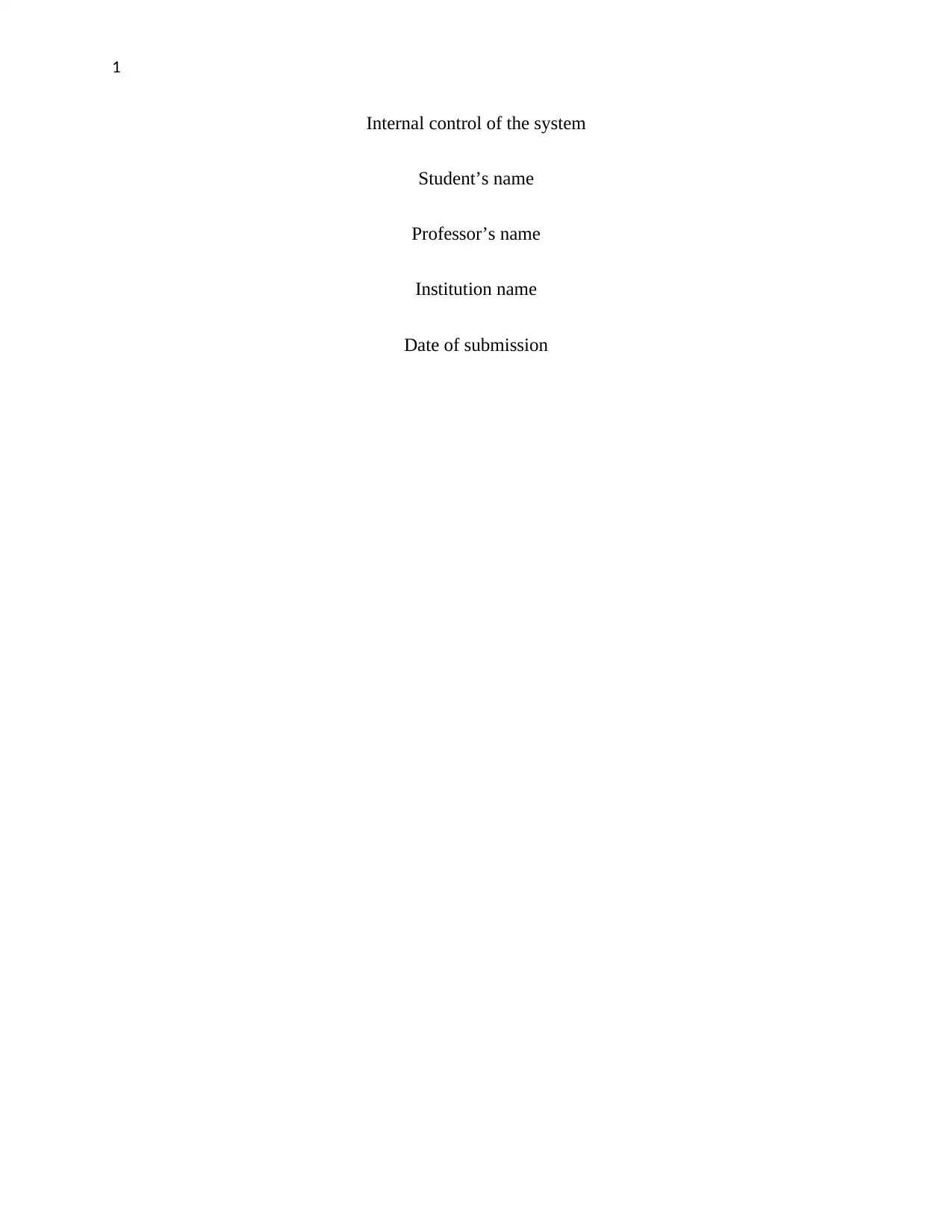
1
Internal control of the system
Student’s name
Professor’s name
Institution name
Date of submission
Internal control of the system
Student’s name
Professor’s name
Institution name
Date of submission
Paraphrase This Document
Need a fresh take? Get an instant paraphrase of this document with our AI Paraphraser
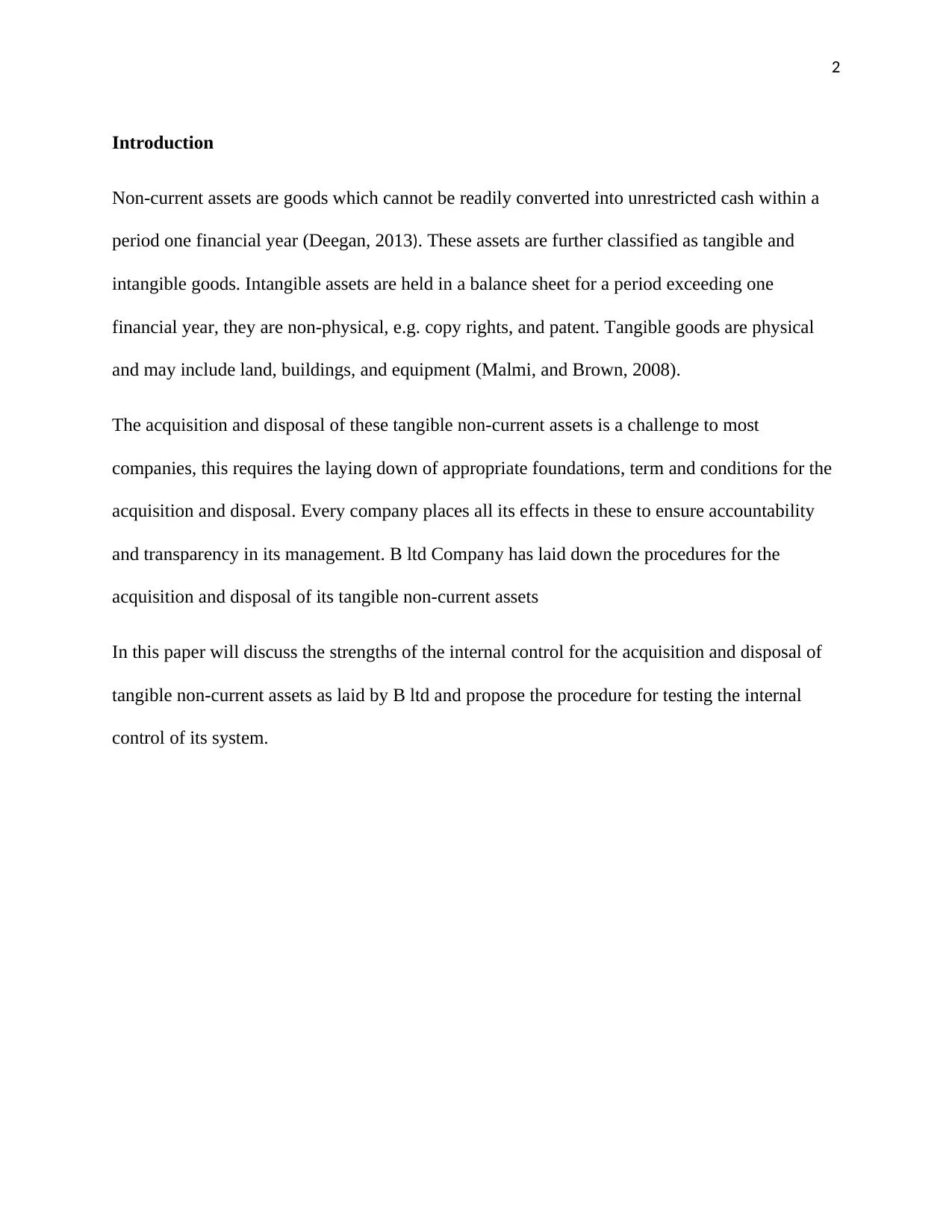
2
Introduction
Non-current assets are goods which cannot be readily converted into unrestricted cash within a
period one financial year (Deegan, 2013). These assets are further classified as tangible and
intangible goods. Intangible assets are held in a balance sheet for a period exceeding one
financial year, they are non-physical, e.g. copy rights, and patent. Tangible goods are physical
and may include land, buildings, and equipment (Malmi, and Brown, 2008).
The acquisition and disposal of these tangible non-current assets is a challenge to most
companies, this requires the laying down of appropriate foundations, term and conditions for the
acquisition and disposal. Every company places all its effects in these to ensure accountability
and transparency in its management. B ltd Company has laid down the procedures for the
acquisition and disposal of its tangible non-current assets
In this paper will discuss the strengths of the internal control for the acquisition and disposal of
tangible non-current assets as laid by B ltd and propose the procedure for testing the internal
control of its system.
Introduction
Non-current assets are goods which cannot be readily converted into unrestricted cash within a
period one financial year (Deegan, 2013). These assets are further classified as tangible and
intangible goods. Intangible assets are held in a balance sheet for a period exceeding one
financial year, they are non-physical, e.g. copy rights, and patent. Tangible goods are physical
and may include land, buildings, and equipment (Malmi, and Brown, 2008).
The acquisition and disposal of these tangible non-current assets is a challenge to most
companies, this requires the laying down of appropriate foundations, term and conditions for the
acquisition and disposal. Every company places all its effects in these to ensure accountability
and transparency in its management. B ltd Company has laid down the procedures for the
acquisition and disposal of its tangible non-current assets
In this paper will discuss the strengths of the internal control for the acquisition and disposal of
tangible non-current assets as laid by B ltd and propose the procedure for testing the internal
control of its system.
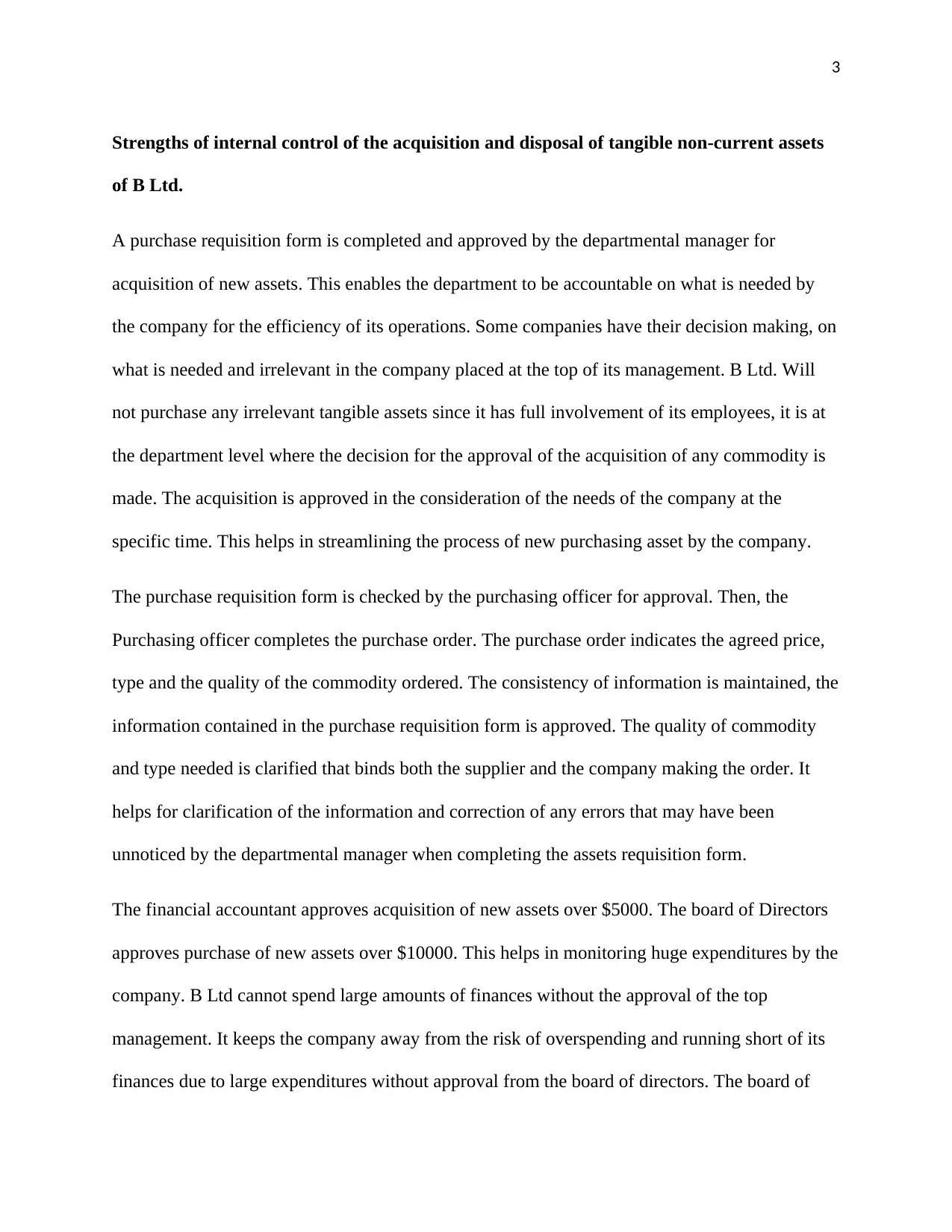
3
Strengths of internal control of the acquisition and disposal of tangible non-current assets
of B Ltd.
A purchase requisition form is completed and approved by the departmental manager for
acquisition of new assets. This enables the department to be accountable on what is needed by
the company for the efficiency of its operations. Some companies have their decision making, on
what is needed and irrelevant in the company placed at the top of its management. B Ltd. Will
not purchase any irrelevant tangible assets since it has full involvement of its employees, it is at
the department level where the decision for the approval of the acquisition of any commodity is
made. The acquisition is approved in the consideration of the needs of the company at the
specific time. This helps in streamlining the process of new purchasing asset by the company.
The purchase requisition form is checked by the purchasing officer for approval. Then, the
Purchasing officer completes the purchase order. The purchase order indicates the agreed price,
type and the quality of the commodity ordered. The consistency of information is maintained, the
information contained in the purchase requisition form is approved. The quality of commodity
and type needed is clarified that binds both the supplier and the company making the order. It
helps for clarification of the information and correction of any errors that may have been
unnoticed by the departmental manager when completing the assets requisition form.
The financial accountant approves acquisition of new assets over $5000. The board of Directors
approves purchase of new assets over $10000. This helps in monitoring huge expenditures by the
company. B Ltd cannot spend large amounts of finances without the approval of the top
management. It keeps the company away from the risk of overspending and running short of its
finances due to large expenditures without approval from the board of directors. The board of
Strengths of internal control of the acquisition and disposal of tangible non-current assets
of B Ltd.
A purchase requisition form is completed and approved by the departmental manager for
acquisition of new assets. This enables the department to be accountable on what is needed by
the company for the efficiency of its operations. Some companies have their decision making, on
what is needed and irrelevant in the company placed at the top of its management. B Ltd. Will
not purchase any irrelevant tangible assets since it has full involvement of its employees, it is at
the department level where the decision for the approval of the acquisition of any commodity is
made. The acquisition is approved in the consideration of the needs of the company at the
specific time. This helps in streamlining the process of new purchasing asset by the company.
The purchase requisition form is checked by the purchasing officer for approval. Then, the
Purchasing officer completes the purchase order. The purchase order indicates the agreed price,
type and the quality of the commodity ordered. The consistency of information is maintained, the
information contained in the purchase requisition form is approved. The quality of commodity
and type needed is clarified that binds both the supplier and the company making the order. It
helps for clarification of the information and correction of any errors that may have been
unnoticed by the departmental manager when completing the assets requisition form.
The financial accountant approves acquisition of new assets over $5000. The board of Directors
approves purchase of new assets over $10000. This helps in monitoring huge expenditures by the
company. B Ltd cannot spend large amounts of finances without the approval of the top
management. It keeps the company away from the risk of overspending and running short of its
finances due to large expenditures without approval from the board of directors. The board of
⊘ This is a preview!⊘
Do you want full access?
Subscribe today to unlock all pages.

Trusted by 1+ million students worldwide
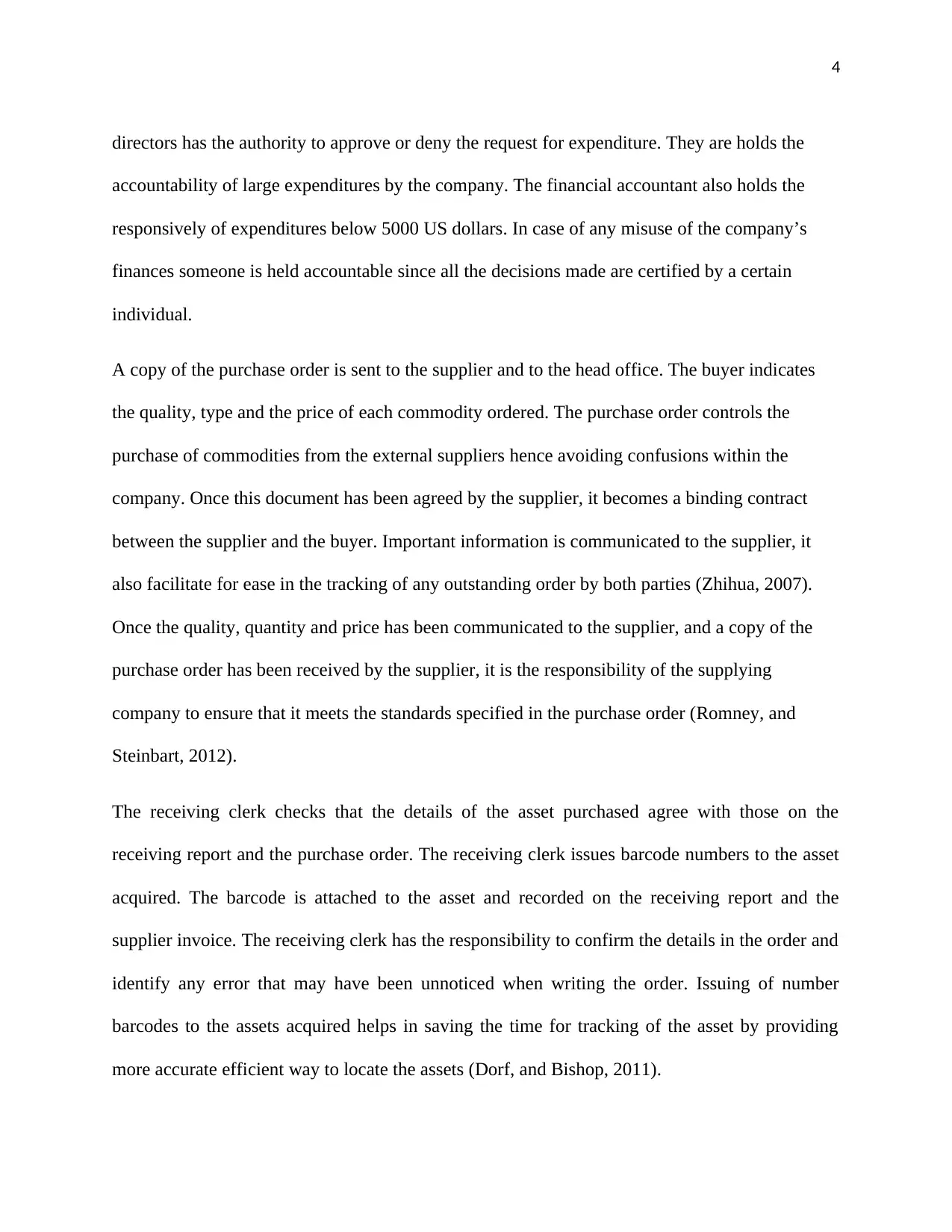
4
directors has the authority to approve or deny the request for expenditure. They are holds the
accountability of large expenditures by the company. The financial accountant also holds the
responsively of expenditures below 5000 US dollars. In case of any misuse of the company’s
finances someone is held accountable since all the decisions made are certified by a certain
individual.
A copy of the purchase order is sent to the supplier and to the head office. The buyer indicates
the quality, type and the price of each commodity ordered. The purchase order controls the
purchase of commodities from the external suppliers hence avoiding confusions within the
company. Once this document has been agreed by the supplier, it becomes a binding contract
between the supplier and the buyer. Important information is communicated to the supplier, it
also facilitate for ease in the tracking of any outstanding order by both parties (Zhihua, 2007).
Once the quality, quantity and price has been communicated to the supplier, and a copy of the
purchase order has been received by the supplier, it is the responsibility of the supplying
company to ensure that it meets the standards specified in the purchase order (Romney, and
Steinbart, 2012).
The receiving clerk checks that the details of the asset purchased agree with those on the
receiving report and the purchase order. The receiving clerk issues barcode numbers to the asset
acquired. The barcode is attached to the asset and recorded on the receiving report and the
supplier invoice. The receiving clerk has the responsibility to confirm the details in the order and
identify any error that may have been unnoticed when writing the order. Issuing of number
barcodes to the assets acquired helps in saving the time for tracking of the asset by providing
more accurate efficient way to locate the assets (Dorf, and Bishop, 2011).
directors has the authority to approve or deny the request for expenditure. They are holds the
accountability of large expenditures by the company. The financial accountant also holds the
responsively of expenditures below 5000 US dollars. In case of any misuse of the company’s
finances someone is held accountable since all the decisions made are certified by a certain
individual.
A copy of the purchase order is sent to the supplier and to the head office. The buyer indicates
the quality, type and the price of each commodity ordered. The purchase order controls the
purchase of commodities from the external suppliers hence avoiding confusions within the
company. Once this document has been agreed by the supplier, it becomes a binding contract
between the supplier and the buyer. Important information is communicated to the supplier, it
also facilitate for ease in the tracking of any outstanding order by both parties (Zhihua, 2007).
Once the quality, quantity and price has been communicated to the supplier, and a copy of the
purchase order has been received by the supplier, it is the responsibility of the supplying
company to ensure that it meets the standards specified in the purchase order (Romney, and
Steinbart, 2012).
The receiving clerk checks that the details of the asset purchased agree with those on the
receiving report and the purchase order. The receiving clerk issues barcode numbers to the asset
acquired. The barcode is attached to the asset and recorded on the receiving report and the
supplier invoice. The receiving clerk has the responsibility to confirm the details in the order and
identify any error that may have been unnoticed when writing the order. Issuing of number
barcodes to the assets acquired helps in saving the time for tracking of the asset by providing
more accurate efficient way to locate the assets (Dorf, and Bishop, 2011).
Paraphrase This Document
Need a fresh take? Get an instant paraphrase of this document with our AI Paraphraser
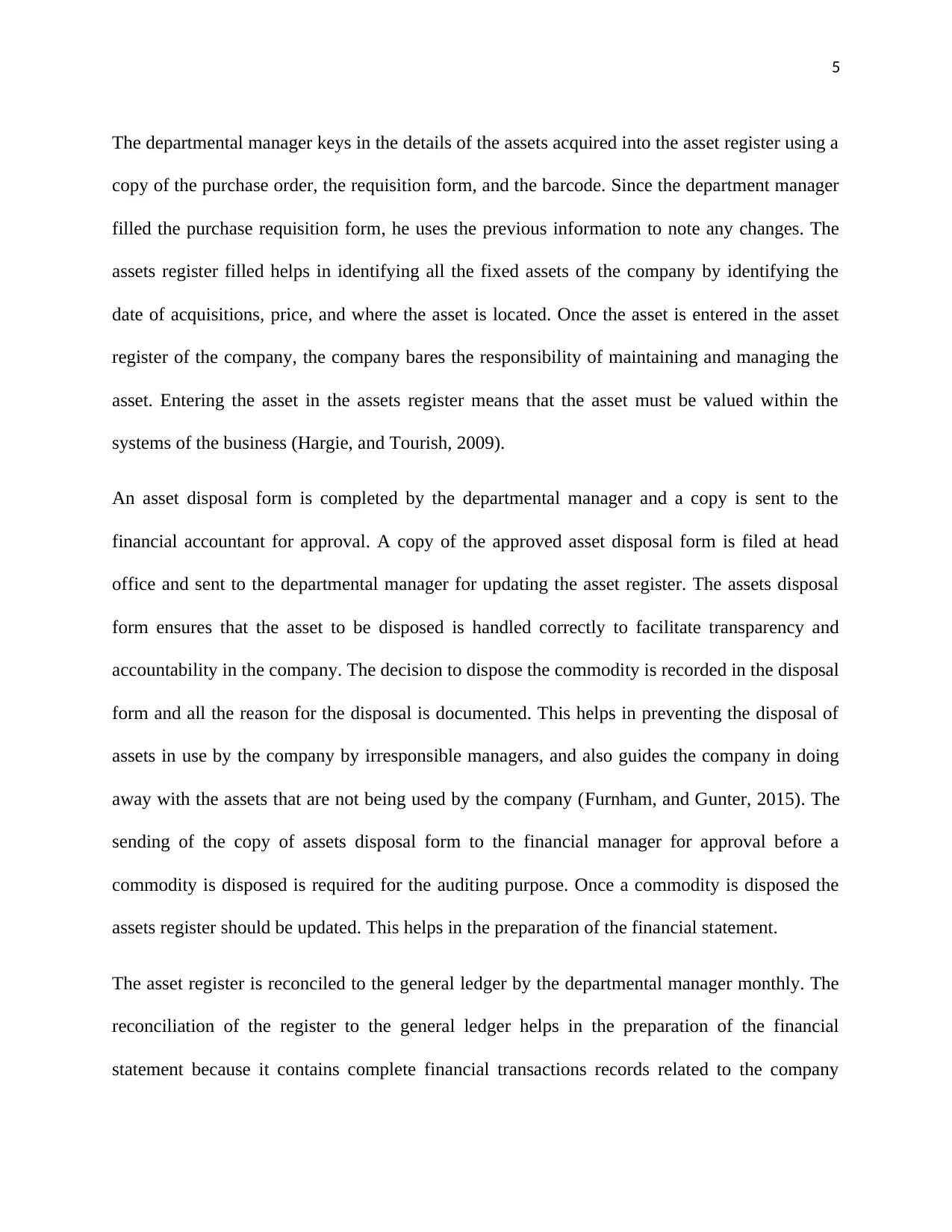
5
The departmental manager keys in the details of the assets acquired into the asset register using a
copy of the purchase order, the requisition form, and the barcode. Since the department manager
filled the purchase requisition form, he uses the previous information to note any changes. The
assets register filled helps in identifying all the fixed assets of the company by identifying the
date of acquisitions, price, and where the asset is located. Once the asset is entered in the asset
register of the company, the company bares the responsibility of maintaining and managing the
asset. Entering the asset in the assets register means that the asset must be valued within the
systems of the business (Hargie, and Tourish, 2009).
An asset disposal form is completed by the departmental manager and a copy is sent to the
financial accountant for approval. A copy of the approved asset disposal form is filed at head
office and sent to the departmental manager for updating the asset register. The assets disposal
form ensures that the asset to be disposed is handled correctly to facilitate transparency and
accountability in the company. The decision to dispose the commodity is recorded in the disposal
form and all the reason for the disposal is documented. This helps in preventing the disposal of
assets in use by the company by irresponsible managers, and also guides the company in doing
away with the assets that are not being used by the company (Furnham, and Gunter, 2015). The
sending of the copy of assets disposal form to the financial manager for approval before a
commodity is disposed is required for the auditing purpose. Once a commodity is disposed the
assets register should be updated. This helps in the preparation of the financial statement.
The asset register is reconciled to the general ledger by the departmental manager monthly. The
reconciliation of the register to the general ledger helps in the preparation of the financial
statement because it contains complete financial transactions records related to the company
The departmental manager keys in the details of the assets acquired into the asset register using a
copy of the purchase order, the requisition form, and the barcode. Since the department manager
filled the purchase requisition form, he uses the previous information to note any changes. The
assets register filled helps in identifying all the fixed assets of the company by identifying the
date of acquisitions, price, and where the asset is located. Once the asset is entered in the asset
register of the company, the company bares the responsibility of maintaining and managing the
asset. Entering the asset in the assets register means that the asset must be valued within the
systems of the business (Hargie, and Tourish, 2009).
An asset disposal form is completed by the departmental manager and a copy is sent to the
financial accountant for approval. A copy of the approved asset disposal form is filed at head
office and sent to the departmental manager for updating the asset register. The assets disposal
form ensures that the asset to be disposed is handled correctly to facilitate transparency and
accountability in the company. The decision to dispose the commodity is recorded in the disposal
form and all the reason for the disposal is documented. This helps in preventing the disposal of
assets in use by the company by irresponsible managers, and also guides the company in doing
away with the assets that are not being used by the company (Furnham, and Gunter, 2015). The
sending of the copy of assets disposal form to the financial manager for approval before a
commodity is disposed is required for the auditing purpose. Once a commodity is disposed the
assets register should be updated. This helps in the preparation of the financial statement.
The asset register is reconciled to the general ledger by the departmental manager monthly. The
reconciliation of the register to the general ledger helps in the preparation of the financial
statement because it contains complete financial transactions records related to the company
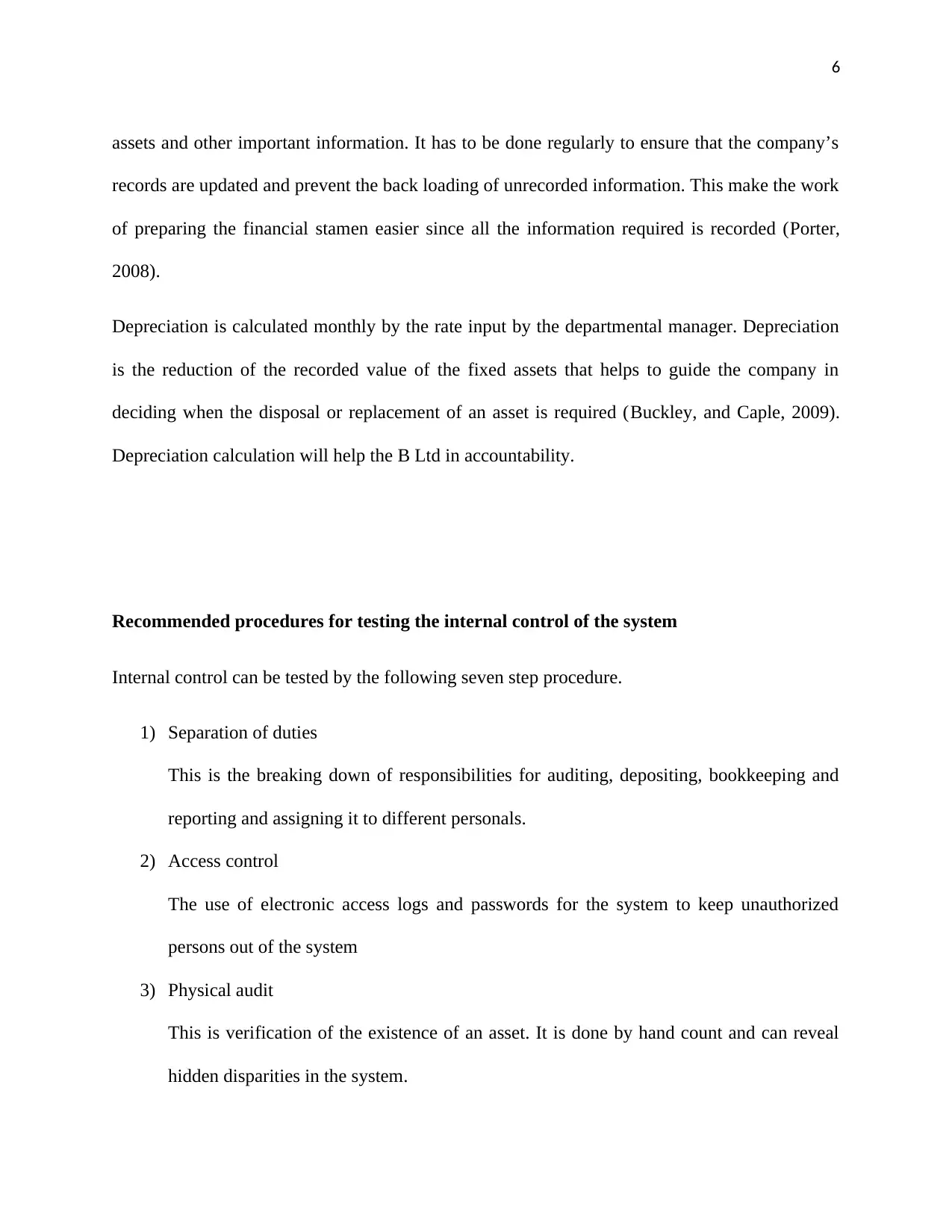
6
assets and other important information. It has to be done regularly to ensure that the company’s
records are updated and prevent the back loading of unrecorded information. This make the work
of preparing the financial stamen easier since all the information required is recorded (Porter,
2008).
Depreciation is calculated monthly by the rate input by the departmental manager. Depreciation
is the reduction of the recorded value of the fixed assets that helps to guide the company in
deciding when the disposal or replacement of an asset is required (Buckley, and Caple, 2009).
Depreciation calculation will help the B Ltd in accountability.
Recommended procedures for testing the internal control of the system
Internal control can be tested by the following seven step procedure.
1) Separation of duties
This is the breaking down of responsibilities for auditing, depositing, bookkeeping and
reporting and assigning it to different personals.
2) Access control
The use of electronic access logs and passwords for the system to keep unauthorized
persons out of the system
3) Physical audit
This is verification of the existence of an asset. It is done by hand count and can reveal
hidden disparities in the system.
assets and other important information. It has to be done regularly to ensure that the company’s
records are updated and prevent the back loading of unrecorded information. This make the work
of preparing the financial stamen easier since all the information required is recorded (Porter,
2008).
Depreciation is calculated monthly by the rate input by the departmental manager. Depreciation
is the reduction of the recorded value of the fixed assets that helps to guide the company in
deciding when the disposal or replacement of an asset is required (Buckley, and Caple, 2009).
Depreciation calculation will help the B Ltd in accountability.
Recommended procedures for testing the internal control of the system
Internal control can be tested by the following seven step procedure.
1) Separation of duties
This is the breaking down of responsibilities for auditing, depositing, bookkeeping and
reporting and assigning it to different personals.
2) Access control
The use of electronic access logs and passwords for the system to keep unauthorized
persons out of the system
3) Physical audit
This is verification of the existence of an asset. It is done by hand count and can reveal
hidden disparities in the system.
⊘ This is a preview!⊘
Do you want full access?
Subscribe today to unlock all pages.

Trusted by 1+ million students worldwide
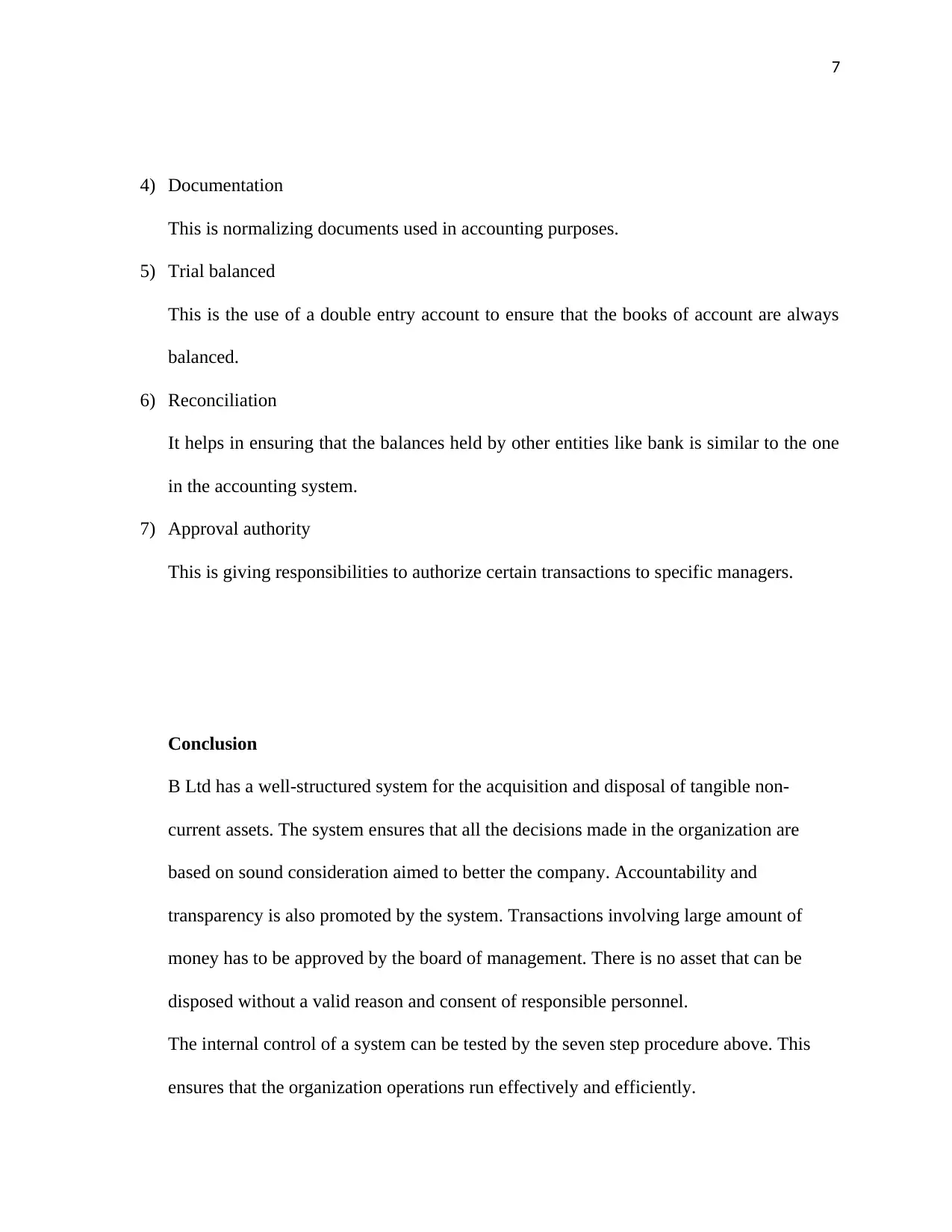
7
4) Documentation
This is normalizing documents used in accounting purposes.
5) Trial balanced
This is the use of a double entry account to ensure that the books of account are always
balanced.
6) Reconciliation
It helps in ensuring that the balances held by other entities like bank is similar to the one
in the accounting system.
7) Approval authority
This is giving responsibilities to authorize certain transactions to specific managers.
Conclusion
B Ltd has a well-structured system for the acquisition and disposal of tangible non-
current assets. The system ensures that all the decisions made in the organization are
based on sound consideration aimed to better the company. Accountability and
transparency is also promoted by the system. Transactions involving large amount of
money has to be approved by the board of management. There is no asset that can be
disposed without a valid reason and consent of responsible personnel.
The internal control of a system can be tested by the seven step procedure above. This
ensures that the organization operations run effectively and efficiently.
4) Documentation
This is normalizing documents used in accounting purposes.
5) Trial balanced
This is the use of a double entry account to ensure that the books of account are always
balanced.
6) Reconciliation
It helps in ensuring that the balances held by other entities like bank is similar to the one
in the accounting system.
7) Approval authority
This is giving responsibilities to authorize certain transactions to specific managers.
Conclusion
B Ltd has a well-structured system for the acquisition and disposal of tangible non-
current assets. The system ensures that all the decisions made in the organization are
based on sound consideration aimed to better the company. Accountability and
transparency is also promoted by the system. Transactions involving large amount of
money has to be approved by the board of management. There is no asset that can be
disposed without a valid reason and consent of responsible personnel.
The internal control of a system can be tested by the seven step procedure above. This
ensures that the organization operations run effectively and efficiently.
Paraphrase This Document
Need a fresh take? Get an instant paraphrase of this document with our AI Paraphraser
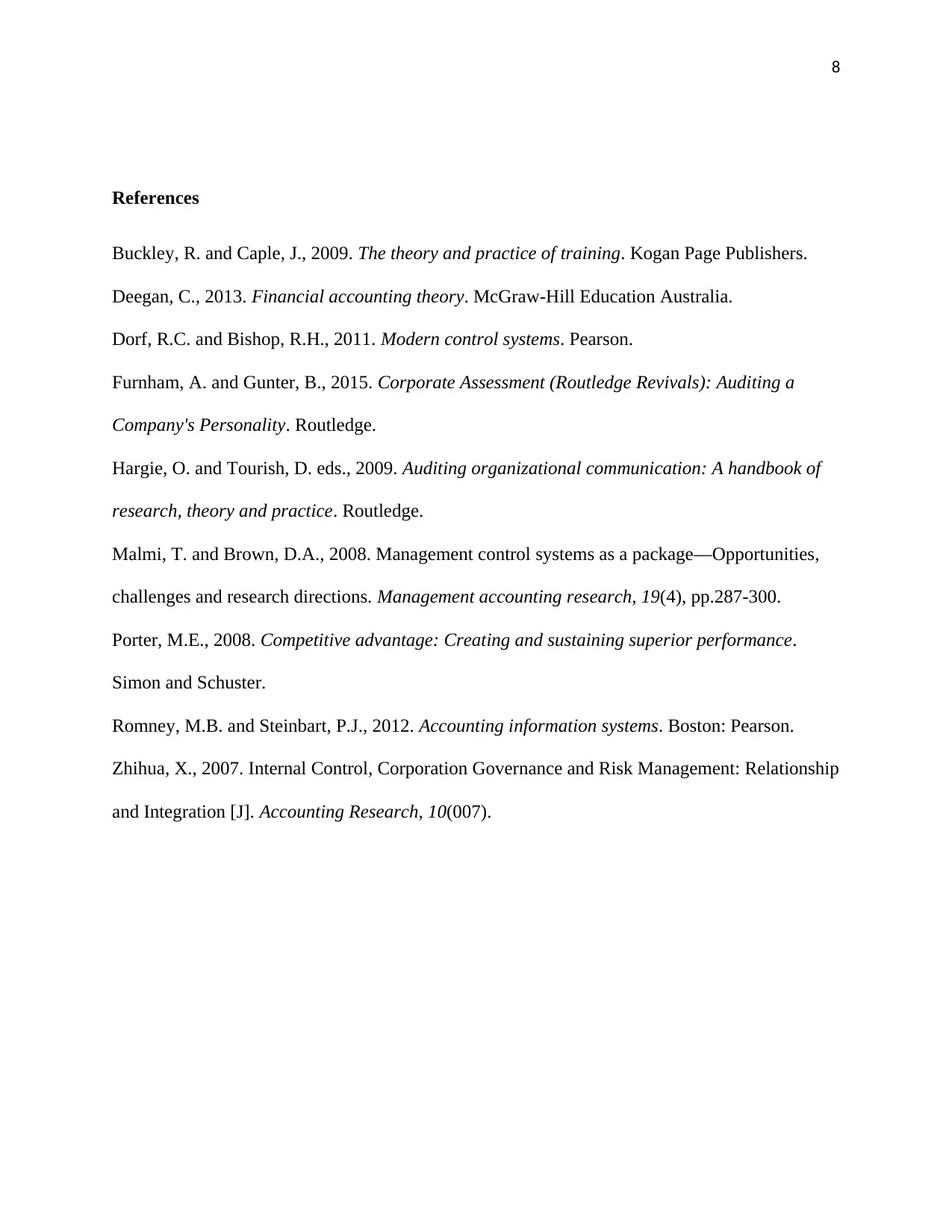
8
References
Buckley, R. and Caple, J., 2009. The theory and practice of training. Kogan Page Publishers.
Deegan, C., 2013. Financial accounting theory. McGraw-Hill Education Australia.
Dorf, R.C. and Bishop, R.H., 2011. Modern control systems. Pearson.
Furnham, A. and Gunter, B., 2015. Corporate Assessment (Routledge Revivals): Auditing a
Company's Personality. Routledge.
Hargie, O. and Tourish, D. eds., 2009. Auditing organizational communication: A handbook of
research, theory and practice. Routledge.
Malmi, T. and Brown, D.A., 2008. Management control systems as a package—Opportunities,
challenges and research directions. Management accounting research, 19(4), pp.287-300.
Porter, M.E., 2008. Competitive advantage: Creating and sustaining superior performance.
Simon and Schuster.
Romney, M.B. and Steinbart, P.J., 2012. Accounting information systems. Boston: Pearson.
Zhihua, X., 2007. Internal Control, Corporation Governance and Risk Management: Relationship
and Integration [J]. Accounting Research, 10(007).
References
Buckley, R. and Caple, J., 2009. The theory and practice of training. Kogan Page Publishers.
Deegan, C., 2013. Financial accounting theory. McGraw-Hill Education Australia.
Dorf, R.C. and Bishop, R.H., 2011. Modern control systems. Pearson.
Furnham, A. and Gunter, B., 2015. Corporate Assessment (Routledge Revivals): Auditing a
Company's Personality. Routledge.
Hargie, O. and Tourish, D. eds., 2009. Auditing organizational communication: A handbook of
research, theory and practice. Routledge.
Malmi, T. and Brown, D.A., 2008. Management control systems as a package—Opportunities,
challenges and research directions. Management accounting research, 19(4), pp.287-300.
Porter, M.E., 2008. Competitive advantage: Creating and sustaining superior performance.
Simon and Schuster.
Romney, M.B. and Steinbart, P.J., 2012. Accounting information systems. Boston: Pearson.
Zhihua, X., 2007. Internal Control, Corporation Governance and Risk Management: Relationship
and Integration [J]. Accounting Research, 10(007).
1 out of 8
Related Documents
Your All-in-One AI-Powered Toolkit for Academic Success.
+13062052269
info@desklib.com
Available 24*7 on WhatsApp / Email
![[object Object]](/_next/static/media/star-bottom.7253800d.svg)
Unlock your academic potential
Copyright © 2020–2025 A2Z Services. All Rights Reserved. Developed and managed by ZUCOL.





